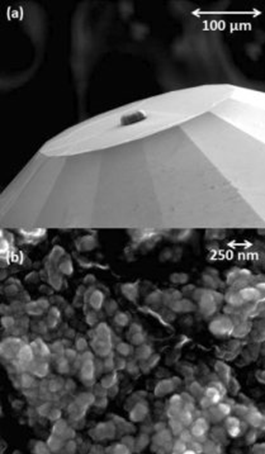The pressure of nanocrystalline diamond produced by plasma vapor deposition is nearly twice as high as that of the Earth's center. A new study found that the manufacturing process of these new nanocrystalline diamond microanvils has proven to be "very consistent" and shows "high repeatability in manufacturing." This agglomerate on the flat surface of the gemstone diamond (top) is a nanocrystalline diamond that is half the width of a typical human hair. The higher magnification (bottom) shows the particle structure of the nanocrystalline diamond. Image source: UAB Dr. Yogesh Vohra's nanocrystalline diamonds produced by plasma vapor deposition have nearly twice the pressure of the Earth's center. Now, he reports in a research report published in the "Science Report" that the manufacturing process of these new nanocrystalline diamond microanvils has been proven to be "very consistent" and has shown "high repeatability of manufacturing." ". Vohra, a professor of physics and a university scholar at the UAB School of Arts and Sciences at the University of Alabama at Birmingham, said: "These results have inspired people to continue researching materials under extreme stress and temperature conditions." Nanocrystalline diamonds look like tiny materials that grow on the flat bottom surface of a one-third-carat gemstone diamond. To construct the agglomerate, the gemstone diamond is coated with a tungsten film centered with a circle of 15 to 20 microns. The nanocrystalline diamond begins to grow on the circumference of the gem diamond surface as tiny diamond grains. Vapor deposition by heating a plasma made of methane, hydrogen and nitrogen forms crystal grains. A plasma is a hot, ionized gaseous substance that is the fourth material state after liquid, solid, and gaseous. The crystallites of nanodiamonds are typically between 5 and 100 nanometers. Vohra and uab colleagues observed the early nucleation morphology of the nanocrystals at one, three and fifteen minutes after the start of the synthesis. They found that the nucleation of the nanocrystalline diamond began to be rapid, without the need to seed a small amount of surface before growth. diamond. Conversely, growing seeds on other surfaces requires such seeds. After one minute of growth, the electron microscope image showed a large number of nucleation sites on the surface of the single crystal gem diamond. At 3 minutes, only a small area of ​​the gemstone surface was covered with nanocrystalline diamond. After 15 minutes, the coverage of the nanocrystalline particles was complete. Uniform, starting to gather together throughout the growing area. Growth slows down between three and six hours, and nanocrystalline diamond tends to coalesce into a hemispherical structure. According to Vohra, this geometry has been observed in the growth experiments of UAB researchers at every two stages. In addition, there seems to be a geometric growth limit. Nanocrystalline blocks greatly increase the pressure that diamond micro anvils can achieve. Single crystal gemstones with a crystal size of 300 microns, without nanocrystals, can only produce pressures of 75 gigapascals. When nanocrystalline diamond is added, the microanvil can produce pressures of up to 500 gigapascals. UAB researchers hope to use their nanocrystalline diamond micro-anvil to achieve a pressure of 1,000 gigapascals or a thousand pascals. This is close to the pressure at the center of Saturn's planet. This enormous pressure can produce new materials that are not known, and can also be used to study the phase transition and compression behavior of materials. In nature, such a huge depth of underground power can turn carbon into diamonds or turn volcanic ash into slate. The UAB team also examined the separation of nanocrystalline diamond micropowders during compression and decompression of the diamond-anvil battery unit. Using electron force microscopy, scanning electron microscopy, and Raman spectroscopy, the researchers found that separation failure occurred in most of the single crystal gem diamond anvil below the bottom surface, rather than at the interface between gem diamond and nanocrystalline diamond agglomerates. At the office. This suggests that the interfacial adhesion strength between gem diamond and nanocrystalline diamond agglomerates appears to be quite large and the interface is able to withstand ultra high shear stresses. Vohra said UAB researchers will continue to study grain size and bond strength at the manipulating interface to optimize nanocrystalline diamond micro-anvil for high pressure research. Natural Organic Resin,Fine Chemicals Series,Leather Brightener Formula,Organic Compound Resin XINGZHILIAN BIOLOGICALR&D CO.,LTD , https://www.xzlsdslds.com
In order to study materials, nanocrystalline diamond is produced under extreme conditions.
Abstract The pressure of nanocrystalline diamond produced by plasma vapor deposition is nearly twice as high as that of the Earth's center. A new study found that the manufacturing process of these new nanocrystalline diamond micro-anvils has been proven to be "very consistent" and shows that "there is a high degree of manufacturing...
